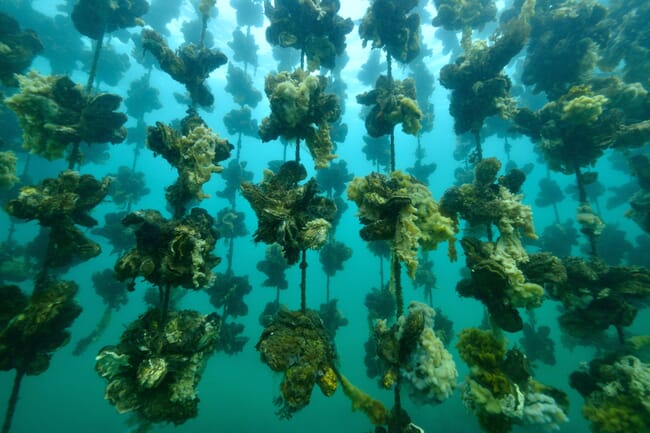
Increasing the cultivation of bivalve species such as oysters would help close the projected supply gap while also tackling biodiversity risks
According to a new report published by non-profit financial think tank Planet Tracker, even in the most optimistic scenario of improving current aquaculture practices, a 50 million tonne supply gap would still exist by 2050, meaning change is critical.
Analysis by Planet Tracker found that while technological solutions – such as farming seafood offshore, or on land or growing fish in labs – could contribute up to 5 million additional tonnes of seafood by 2050, embracing regenerative aquaculture – the production of food from the sea that provide benefits to the ecosystem, such as water filtering by bivalves (eg oysters, mussels and clams) or carbon sequestration by seaweed – could produce an additional 45 million tonnes of seafood and meet growing demand.
However, the report – Avoiding Aquafailure: aquaculture diversification and regeneration are needed to feed the world – reveals that at least $55 billion is needed in capital expenditure to finance this transition, which most aquaculture companies cannot afford.
The report signals that a business-as-usual approach with concentrated fish monocultures will lead to a variety of biodiversity risks, with impacts from nutrients pollution to native species displacement, resulting in financial losses to the industry. Latest research finds an increasingly concentrated industry with the top ten seafood-producing counties accounting for 89% of the total seafood production – and over 75% of listed aquaculture companies farming salmon, shrimp or pangasius.
As François Mosnier, head of oceans programme at Planet Tracker, explained in a press release: “On land, the conversion of natural habitat into monoculture is widely recognised as a key driver of biodiversity loss, but less acknowledged are the similar patterns affecting marine life due to monoculture fish farming. Unsustainable seafood production will not feed the world by 2050, but the good news is that an aquaculture industry that is resilient, productive and environmentally sustainable can be built.”
The report calls on investors and lenders to finance this regenerative transition by:
- Being aware of the increasing risks to production in a business-as-usual scenario due to concentration, coastal conflict, production at intensities above sustainable limits and upcoming regulatory pressures.
- Demanding better disclosure, transparency and traceability procedures from companies to assist in better quantification and mitigation of these risks.
- Supporting the mitigation of these risks through diversification of species and geographic distribution, especially if the species involved allow ecosystem restoration and provided that expansion in new areas does not increase the company’s impact on biodiversity investments.
- Supporting the mitigation of these risks through technology which enables offshore, RAS and cultivated seafood, but only if it is environmentally sound to do so.
- Supporting regenerative aquaculture investments, for instance by offering cheaper capital for sustainable expansion, including via sustainability-linked bonds.




